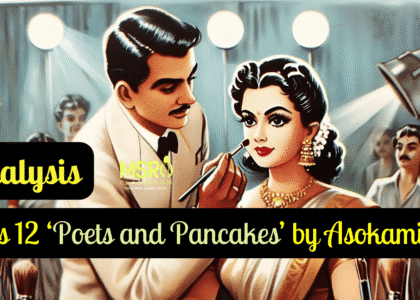Chapter 5- Louis Fischer’s ‘Indigo’ Summary, Theme, Explanation, Character Sketch, Textbook Questions/Answers.
Chapter 5- ‘Indigo’ by Louis Fischer
Table of Contents:
Also Read: Class 12 “Poets And Pancakes” by Asokamitran, “The Rattrap” by Selma Lagerlof
Summary ‘Indigo’ by Louis Fischer:
- The excerpt from Louis Fischer‘s “The Life of Mahatma Gandhi” recounts Gandhi’s pivotal role in the Champaran Satyagraha of 1917. In response to the unjust indigo cultivation system imposed by British landlords in Bihar, Gandhi, prompted by sharecropper Rajkumar Shukla, investigated the situation.
- Despite British intimidation, Gandhi persisted, facing court summons and sparking a demonstration of thousands of peasants. His civil disobedience strategy, coupled with the support of prominent lawyers like Rajendra Prasad, led to a 50% refund agreement for sharecroppers, ending indigo sharecropping within a few years.
- Champaran marked a turning point in Gandhi’s life, showcasing his commitment to practical issues affecting the masses and his emphasis on self-reliance and Indian independence. Gandhi’s approach intertwined politics with everyday problems, emphasising loyalty to living beings over abstractions and teaching a lesson in self-reliance to his followers, like Charles Freer Andrews.

Shop: MSRO SMART NOTES: Class 12 English Literature
Theme ‘Indigo’ by Louis Fischer:
The excerpt from Louis Fischer’s book The Life of Mahatma Gandhi highlights Gandhi’s leadership in securing justice for oppressed people, mainly through his actions in Champaran. Here, the theme revolves around Gandhi’s approach to obtaining justice through convincing argumentation, negotiation, and his dedication to the welfare of the oppressed.
Main Themes:
- Leadership for Justice: Gandhi’s leadership is depicted in his response to Rajkumar Shukla’s plea and subsequent actions in Champaran. Despite facing opposition and threats, Gandhi persisted in his efforts to address the grievances of the sharecroppers and secure justice.
- Convincing Argumentation and Negotiation: Gandhi’s approach involved engaging with authorities through reasoned argumentation and negotiation rather than resorting to violence or aggression. He demonstrated the power of peaceful resistance and civil disobedience to bring about change.
Sub-Theme:
Contributions of Anonymous Indians: The excerpt also highlights the contributions of anonymous individuals like Rajkumar Shukla, whose determination and perseverance played a crucial role in drawing Gandhi’s attention to the plight of the oppressed. These unsung heroes represent the collective spirit of the Indian freedom movement and underscore the significance of grassroots activism.
Explanation of ‘Indigo’ for Auditory Learners:
Duration: 11 minutes
Exam-Focused. Concise. Note Style
Character Sketch:
Based on the excerpt from Louis Fischer’s book ‘The Life of Mahatma Gandhi’ (1950), the character sketch of Gandhi can be drawn as follows:
- Compassionate Leader: Mahatma Gandhi, depicted in Louis Fischer’s “The Life of Mahatma Gandhi,” embodies compassion and empathy, notably displayed through his encounter with Rajkumar Shukla, a poor peasant from Champaran.
- Courageous Activist: Gandhi’s refusal to comply with British authorities’ orders, despite intimidation and threats, showcases his unwavering courage and determination in confronting oppression.
- Principled Advocate: Gandhi’s commitment to nonviolent resistance and civil disobedience highlights his adherence to principles of truth, justice, and morality, embodying the philosophy of satyagraha.
- Practical Organizer: As a charismatic leader, Gandhi mobilises and inspires thousands of peasants in Champaran to stand against tyranny, highlighting his leadership and organisational skills.
- Practical Visionary: Gandhi’s pragmatic approach to activism seeks tangible solutions to peasants’ immediate problems, such as securing refunds from exploitative landlords and addressing education and healthcare issues.
- Self-reliant Mentor: Rejecting external support, Gandhi emphasises self-reliance and independence, reflecting his belief in the innate strength and resilience of the Indian people.
- Transformative Legacy: Gandhi’s actions in Champaran reflect his visionary quest for a liberated India characterised by social, economic, and political equality, leaving a lasting legacy of compassion, courage, and empowerment.
Textbook Questions/Answers ‘Indigo’:
Think As You Read:
| Q1. Strike out what is not true in the following. a. Rajkumar Shukla was (i) a sharecropper. (ii) a politician. (iii) delegate. (iv) a landlord. b. Rajkumar Shukla was (i) poor. (ii) physically strong. (iii) illiterate. A1: a. (ii) A politician. b. Rajkumar Shukla was: (ii) Physically strong. Q2. Why is Rajkumar Shukla described as being ‘resolute’? A2: Rajkumar Shukla is described as being ‘resolute’ because he persisted in his efforts to bring Gandhi to Champaran despite Gandhi’s initial reluctance. He followed Gandhi everywhere, never leaving his side for weeks, and continued to urge Gandhi to visit his district until Gandhi agreed. This determination and persistence despite obstacles demonstrate Shukla’s stubborn nature. Q3. Why do you think the servants thought Gandhi to be another peasant? A3: The servants likely thought Gandhi to be another peasant because he was accompanied by Rajkumar Shukla, who appeared to be a poor yeoman or peasant himself. Since Gandhi was with Shukla and was not recognised as a prominent figure, the servants may have assumed he was also a peasant like Shukla, especially considering the hierarchical social structure of the time, where distinctions based on caste and social status were prevalent. Q4: List the places Gandhi visited between his first meeting with Shukla and his arrival at Champaran. A4: Gandhi visited the following places between his first meeting with Shukla and his arrival at Champaran: Cawnpore Calcutta Patna Muzzafarpur Q5: What did the peasants pay the British landlords as rent? What did the British now want instead, and why? What would be the impact of synthetic indigo on the prices of natural indigo? A5: The peasants paid the British landlords 15% of their holdings as rent, which was surrendered as the entire indigo harvest. The British landlords now wanted compensation for releasing the peasants from the 15% arrangement due to the development of synthetic indigo. Synthetic indigo would impact the prices of natural indigo by reducing demand for it, thereby decreasing its price. Q6: The events in this part of the text illustrate Gandhi’s method of working. Can you identify some instances of this method and link them to his ideas of satyagraha and non-violence? A6: Gandhi’s method of working in Champaran reflects his principles of satyagraha (truth-force) and non-violence: Truth and Non-violence: Gandhi addressed the suffering of peasants truthfully and non-violently. Civil Disobedience: He defied orders to leave Champaran, facing non-violent persecution. Mass Mobilization: Gandhi mobilised thousands non-violently to support the cause. Negotiation and Compromise: He negotiated for justice while willing to compromise for practical solutions. Empowerment: Gandhi empowered peasants by instilling courage and promoting rights through non-violent means. In Champaran, Gandhi’s approach showcased his commitment to truth, non-violence, civil disobedience, negotiation, and empowerment of the marginalised. Q7: Why did Gandhi agree to a settlement of a 25 per cent refund to the farmers? A7: Gandhi agreed to a 25 per cent refund settlement to the farmers because he prioritised the principle of the landlords surrendering part of the money they had illegally obtained from the sharecroppers over the refund amount. He believed the landlords’ concession was more important than the specific monetary figure. Gandhi aimed to demonstrate to the peasants that they had rights and defenders, and by accepting the 25 per cent refund, he effectively broke the deadlock and initiated progress towards addressing the injustice faced by the peasants. Q8: How did the episode change the plight of the peasants? A8: The episode changed the plight of the peasants in several ways: End of Indigo Sharecropping: The settlement reached with the landlords marked the end of the oppressive indigo sharecropping system. The landlords eventually abandoned their estates, which were then returned to the peasants, thereby freeing them from the exploitative arrangement. Empowerment and Courage: Through Gandhi’s actions and the subsequent events, the peasants gained a sense of empowerment and courage. They realised that they had rights and defenders willing to stand up against injustice on their behalf. Cultural and Social Development: Gandhi addressed the economic injustices and focused on the cultural and social backwardness of the Champaran villages. He initiated efforts to improve the villages’ education, sanitation, and health conditions, demonstrating his holistic approach to social reform. Lesson in Self-Reliance: Gandhi’s refusal to rely on an Englishman’s help during the struggle emphasised the importance of self-reliance and self-determination in the fight for justice and independence. The lesson resonated with his followers and contributed to their understanding of the principles underlying the struggle for freedom. |
Understanding The Text:
Q1: Why do you think Gandhi considered the Champaran episode to be a turning point in his life?
A1: Gandhi considered the Champaran episode to be a turning point in his life for several reasons:
- It marked his first significant involvement in India’s struggle for independence against British colonial rule.
- Champaran was where Gandhi first applied his philosophy of satyagraha (nonviolent resistance) on a large scale, demonstrating its effectiveness in achieving social and political change.
- Gandhi’s success in Champaran boosted his credibility and reputation as a leader in India’s freedom movement, laying the foundation for his future endeavours.
- The Champaran episode showcased Gandhi’s commitment to addressing the practical, day-to-day problems of the masses, intertwining his politics with grassroots activism and social reform.
Q2. How was Gandhi able to influence lawyers? Give instances.
A2: Gandhi was able to influence lawyers in several ways during the Champaran episode:
- He challenged their traditional methods of legal advocacy by advocating for civil disobedience and nonviolent resistance as more effective means of addressing the grievances of the sharecroppers.
- Gandhi criticised lawyers for charging high fees to impoverished peasants and urged them to prioritise the well-being of the oppressed over monetary gain.
- By demonstrating his willingness to face imprisonment and hardship for the sake of justice, Gandhi inspired lawyers to reconsider their roles and responsibilities in society.
- Gandhi’s principled stance and moral leadership compelled the lawyers to join him in his struggle, ultimately leading to their participation in civil disobedience and resolving the crisis in Champaran.
Q3. What was the attitude of the average Indian in smaller localities towards advocates of ‘home rule’?
A3: The attitude of the average Indian in smaller localities towards advocates of ‘home rule’ (self-governance or independence from British rule) was characterised by fear and apprehension:
- Many Indians in smaller localities were afraid to openly express support for advocates of home rule due to the repressive nature of British colonial rule and the potential consequences of dissent.
- The pervasive atmosphere of fear and intimidation created by British authorities made it difficult for ordinary Indians to align themselves with political movements seeking independence openly.
- Gandhi’s comment about the extraordinary nature of a government professor harbouring him reflects the prevailing fear among Indians in smaller localities of showing sympathy for advocates of home rule, as such actions were often met with reprisals from colonial authorities.
Q4. How do we know that ordinary people too, contributed to the freedom movement?
A4: Ordinary people contributed to the freedom movement in several ways, as evidenced by the Champaran episode and Gandhi’s broader philosophy of nonviolent resistance:
- In Champaran, peasants like Rajkumar Shukla played a crucial role by bringing their grievances to Gandhi’s attention and mobilising support for their cause.
- The spontaneous demonstrations of thousands of peasants outside the courthouse in Champaran reflected the widespread desire for change and resistance against British oppression.
- Ordinary Indians participated in civil disobedience campaigns, protests, and boycotts organised by Gandhi and other leaders, demonstrating their commitment to the cause of independence.
- Gandhi emphasised the importance of empowering ordinary Indians to assert their rights and challenge unjust laws through nonviolent means, recognising their integral role in achieving freedom from colonial rule.
Talking about the Text:
Discuss the following.
1. “Freedom from fear is more important than legal justice for the poor.” Do you think that the poor of India are free from fear after Independence?
A: The statement “Freedom from fear is more important than legal justice for the poor” reflects Gandhi’s belief in empowering marginalised and oppressed communities. While legal justice is essential for ensuring rights and addressing grievances, freedom from fear speaks to a deeper sense of security, dignity, and autonomy for individuals, especially the poor and disadvantaged.
After Independence, the extent to which the poor in India are free from fear varies widely across different contexts and regions. While significant progress has been made regarding legal frameworks, social welfare programs, and economic development, challenges such as poverty, social inequality, corruption, and violence persist. Many marginalised communities continue to face various forms of fear, including fear of exploitation, discrimination, violence, and insecurity.
Efforts to address these issues require legal reforms, social policies, and broader societal transformations, including changes in attitudes, behaviours, and power dynamics. Building inclusive and equitable societies where all individuals can live without fear requires sustained efforts from government institutions, civil society organisations, communities, and individuals.
2. The qualities of a good leader.
The qualities of a good leader, as exemplified by Mahatma Gandhi in the excerpt, include
- Compassion and empathy: Gandhi showed deep empathy for the plight of the poor and marginalised, actively engaging with their struggles and working to alleviate their suffering.
- Courage and conviction: Gandhi demonstrated immense courage in confronting injustice and oppression, even amid intimidation and threats from authorities.
- Integrity and humility: Gandhi’s actions were guided by principles of truthfulness, honesty, and moral integrity. He remained humble and committed to serving others, eschewing personal gain or glory.
- Vision and strategic thinking: Gandhi had a clear vision of a free and independent India and formulated strategic approaches to achieve this goal, mobilising mass movements and employing nonviolent resistance tactics.
- Self-reliance and empowerment: Gandhi emphasised the importance of self-reliance and empowerment, encouraging individuals and communities to take ownership of their struggles and work towards their liberation.
- Commitment to justice and equality: Gandhi was unwavering in his commitment to justice, equality, and human rights, advocating for the rights and dignity of all individuals, regardless of caste, class, or creed.
These qualities highlight the transformative potential of ethical leadership grounded in moral principles, humility, and a deep sense of service to humanity.
Working with Words:
• List the words used in the text related to legal procedures.
A: Specialist vocabulary used in legal parlance:
- Sharecroppers: Individuals who farm land owned by others and pay a portion of their crops as rent.
- Litigate: To engage in legal proceedings or to bring a lawsuit.
- Arable land: Land suitable for growing crops.
- Official inquiry: A formal investigation conducted by government authorities.
- Magistrate: A judicial officer who typically presides over minor legal cases.
- Civil disobedience: The deliberate refusal to obey certain laws, demands, or commands of a government.
- Summons: An official order to appear before a court or magistrate.
- Bail: The temporary release of an accused person awaiting trial, sometimes secured by a sum of money.
- Commission of inquiry: A group formed to investigate and report on specific issues.
- Depositions: Testimonies given under oath, typically outside of court, which can be used as evidence in legal proceedings.
- Settlement: An agreement reached between parties to resolve a legal dispute.
- Plead guilty: To formally admit to committing the offence or wrongdoing charged.
- Defendants: Individuals or entities against whom legal action is taken or accused in court.
- Prosecutor: The legal representative who brings charges in a court case on behalf of the government.
- Penalty: The punishment imposed for breaking a law or rule.
- Admonish: To caution or reprimand someone firmly.
- Desist: To cease or abstain from doing something.
- Obedience to the higher law of our being: A reference to a moral or ethical principle that supersedes human-made laws.






